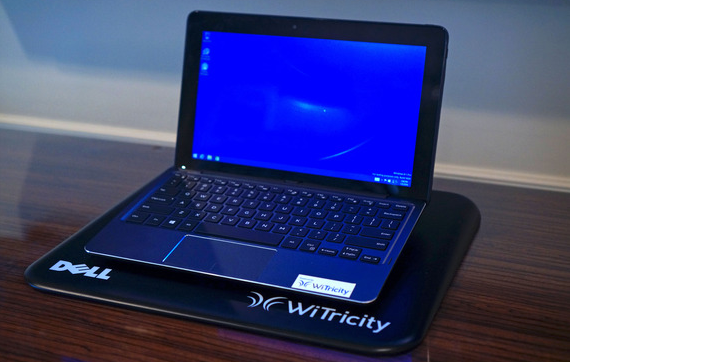Unlike most wireless-charging technologies, WiTricity sends power to devices at the same rate as a hard-wired connection. We saw a prototype of a Dell notebook that charged at full speed while resting on a small wireless charging pad.
In a demonstration of the technology, WiTricity modified two off-the-shelf laptops to charge wirelessly by plopping them onto charging pads. The laptops worked as expected and charged at rates up to 30 watts.
WiTricity didn’t announce which PC OEMs were adopting the tech but said several companies had climbed aboard with actual laptops shipping this year. If I had to guess, I’d say Dell is aboard, as its corporate logo was featured prominently on the prototype charging pad.
WiTricity technology uses oscillating magnetic fields to send electricity — in amounts ranging from milliwatts to kilowatts — to electronic devices within a short distance. A WiTricity representative told us that in the near future, we’ll be effortlessly charging our devices so frequently that low batteries will be a thing of the past. Transmitting power through magnetic resonance also removes the heat-based limitations of inductive charging, as speeds ramp up two-to-three-fold when the problem of overheating is removed.
Another major benefit of sending power via magnetic resonance — instead of through magnetic induction — is that devices can be charged through materials like wood, granite, plastic, glass and even the human body. As a result, sensors can be hidden under furniture, further removing the clutter of cords and charging bays from our lives.
WiTricity points out that an advantage its tech has over the inductive charging used by smartphones is a much larger landing zone. With inductive charging you typically have to line up the device and charger just right to get it to work. With the WiTricity demo, it was better—but not perfect. At this stage though, it’s mostly a limitation of the charging pads in use, but the company says there’s really no limit to how large the surface could be.
Another demonstration showed that wearables can be charged in seamless, more elegant ways. A smart watch dropped onto a peg instantly began to charge without needing to align any ports. We also saw a mockup of a laptop stand with two shelves — one on top that would charge a notebook, and another below that charged a phone. A desk could be engineered to charge all the devices resting on its surface, and a garage could charge any electric car parked inside.
Intel believes in this technology so much that the company is an investor of WiTricity, as well as a licensee of its technology. WiTricity is also a part of the Intel No Wires initiative, and major OEMs are looking to ship laptop charging products in 2016.
You can imagine a future where your entire desk is a charging pad and the only effort required to charge your laptop, phone, eReader, and smartwatch is to put them down.
